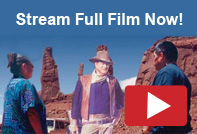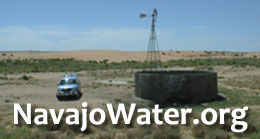FOR IMMEDIATE RELEASE
Navajo Boy Film and Media Campaign Guides EPA to Environmental Justice
Navajo Activist and Filmmaker Present their Story Today at EPA Headquarters
WASHINGTON DC — A documentary film and decade long media campaign by Groundswell Educational Films and a Navajo family opened eyes in Congress and paved the way this summer for the Environmental Protection Agency’s (EPA) first ever cleanup of a Cold War uranium mine on Native American land.
A Sundance Film Festival and PBS selection The Return of Navajo Boy film, and the Navajo family in it, triggered a federal investigation of uranium houses. After ten years of activism — screenings, public events, media coverage and online advocacy — the innovative media campaign and strong Navajo community voices led to the EPA’s $7.5 million cleanup of the abandoned uranium mine adjacent to the homesite of the family in The Return of Navajo Boy film in Monument Valley UT. Skyline Mine is one of more than 500 abandoned uranium mines listed in the EPA’s 5 year plan to cleanup Cold War uranium contamination in the Navajo Nation. In 2007 Congressman Henry Waxman (D-California) introduced a congressional investigation by describing the situation as “a forty year history of bipartisan failure and a modern American tragedy”.
To commemorate Native American Heritage Month the EPA is sponsoring a presentation today by Groundswell co-founder, Jeff Spitz, director of the film and Navajo environmental activist Mary Begay, whose family is featured in the film. Spitz, an Associate Professor of documentary film at Columbia College Chicago and Begay, an elementary school teacher in the Navajo Nation, will present film clips, websites, webisodes, science curriculum and social media that chronicle their campaign and the unfolding federal response. The presentation begins at 11:00AM, Nov. 16 in Rachel L. Carson Great Hall, 1200 Pennsylvania Ave. NW.
“Our work with Groundswell points to the urgent need for more education in impacted Navajo communities where radioactive waste contaminates houses, water, soil and livestock,” said Mary Begay.
“While the media flocked to Japan’s radiation crisis, the Navajo Nation struggles to secure a federal clean up of Cold War uranium contamination,” says director Jeff Spitz. “Stories and film are powerful tools to create empathy and communicate across cultures. Groundswell uses new media tools to give voice, public engagement strategies to advocate for environmental justice, and mainstream media to amplify stories.”
Groundswell Educational Films, based in Chicago, has been actively booking screenings and presentations for 10 years, leveraging media coverage for the issue and creating a platform for the Navajo community to advocate for EPA cleanup. “Transferring media skills to community members continues to be a key to the success of this project,” said Spitz. Accomplishments include triggering the investigation of uranium houses; gaining compensation for ailing former uranium miners and helping the Navajo Nation to move Congress to authorize the five agencies–Nuclear Regulatory Agency, Dept of Energy, Indian Health Service, Bureau of Indian Affairs and EPA to work together to cleanup the contamination.
The 27,000 square miles of the Navajo Nation contain the largest uranium deposits in the US and more than 500 abandoned Cold War era uranium mines according to the US EPA, which continue to contaminate land, water and homes and impact the health of residents.
- 1950s-1970s: The US government failed to warn Navajos about the dangers of uranium mining and radioactive waste despite the fact that the United States government was the sole purchaser of all the uranium.
- In 1990 Congress passed the Radiation Exposure Compensation Act (RECA). RECA represents an official government apology to victims of America’s Cold War nuclear program. RECA expressly acknowledges the United States’ failure to warn three groups of victims: uranium miners, on-site atomic test victims and downwind communities exposed to fallout from the atomic bomb tests.
- In 2000 The Return of Navajo Boy premieres at the Sundance Film Festival, raising awareness of “uranium houses”. Later that year, the EPA removed these structures from Navajo lands.
- In 2005 the Navajo Nation became the first indigenous government to ban uranium mining and exploration on its lands.
- In 2006 and 2007 Congress, led by Henry Waxman (D-California, Chair of the Budget and Government Oversight Committee) sought direct testimony from Navajo officials and demanded a plan of action from the five federal agencies responsible for what Waxman described as a “40 year history of bipartisan failure and a modern American tragedy”.
- In 2008 Groundswell and Navajo family members screened the film and a new epilogue on Capitol Hill.
- In 2008, Congress authorized a comprehensive 5-year plan to coordinate the clean up of contaminated structures, soil and water in the Navajo Nation.
- In April 2011 US EPA began its clean up operation in Monument Valley at the abandoned Skyline Mine which contaminated the homesite of the Navajo family featured in The Return of Navajo Boy.
About Groundswell Educational Films: Groundswell is a non-profit organization with a mission to collaborate cross-culturally in all facets of documentary filmmaking, transfer media skills into disadvantaged communities, and partner with stakeholders to stimulate local actions that address social justice issues raised in our films. Groundswell engages audiences through film, live performances and multi-arts programming and amplifies marginalized voices through new and traditional media.














Leave a Reply
You must be logged in to post a comment.